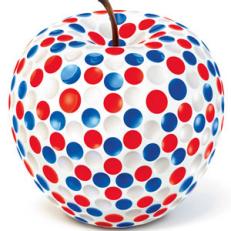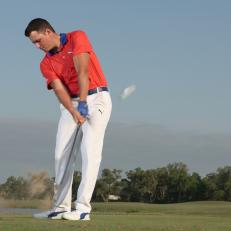
BYE-BYE BANANA
If you fight a slice, you might think you're swinging out to the target, but I'll bet you're swinging well left. Try this: Align everything down the middle of the fairway but swing the clubhead toward a specific target more to the right. Take a strong grip (hands turned to the right), relax your forearms and make a full turn. You'll love that nice, high draw.
DRILL: HIT DOWN ON IT
The key to good iron play is hitting the ball, then the ground. With a 7-iron, set up to a ball and place four balls in a line opposite the outside edge of your rear foot, perpendicular to the target line. Hit shots avoiding the line of balls as you swing down. You'll feel yourself shifting toward the target and bottoming out your swing in front of the ball you're hitting.
DRILL: RIGHT ARM ONLY
To feel the correct swinging motion of the clubhead with your driver--and to improve your forward weight shift--make some practice swings with your right arm only. The object of this drill is to train you to avoid getting too aggressive with your hands and arms when starting the downswing. When you do it correctly, you'll finish in balance on your front foot, with your upper body facing the target. Remember the feel of these smooth right-arm-only swings when you go back to your normal technique.
DO YARD WORK
There's no better indicator of quality iron shots than well-shaped divots. Controlling their length and depth goes hand in hand with making flush contact with the ball. Here's something you can do to assess and monitor your divots: Set aside 10 minutes in your back yard every day to make swings with an 8-iron and no ball. Practice taking divots so that the holes you leave behind: (1) point to your target; (2) are long and thin, not short and deep; and (3) terminate in front of the tip of your left shoe. And don't forget to fix 'em!
SOFTEN YOUR HANDS
Trying to hammer your tee shots can induce tension and prevent you from squaring the clubface. A big slice results. Relax your grip pressure a little. You'll hit the ball just as far, and the improved release through impact will fix that slice.
ACCELERATE!
When you lose that nice ball flight on iron shots, ignore what your friends say about swinging easier. Don't be afraid to take a good rip at it. Try to accelerate through impact. More speed means more spin and a higher, stronger flight.
SHUT THE FACE
If you're struggling to hit the ball solid, your clubface might be too open during the swing. You've got to square that face. Rotate your left hand away from the target on the grip, and let the face feel "hooded," or closed, through impact.
PUTT THUMBS UP
For better speed control and a great roll, make practice strokes with the putterhead hovering off the ground and your thumbs raised slightly off the grip. You'll develop better feel for the putter and make a smoother motion.
DRILL: PERFECT BLAST
Set up to an imaginary ball in the sand as if you were going to hit a 9-iron off the fairway. Shift your feet into the sand, then make a three-quarter swing from this setup. See how much sand you take? That's how much you want to blast out on a normal greenside shot.
YARDSTICK SLICE CURE
To get rid of a slice, you must fix an open clubface. Make slow-motion swings with a yardstick, the side with the measurements facing the target. When you swing down, your goal is to never see those markings. If you do, your "clubface" is still open.
DRILL: STAY DRY TO FIX YOUR PATH
High-handicappers believe--often rightfully so--that they can fix the dreaded outside-in swing path and the slice that results by simply swinging more in to out. They often overdo it, however, and turn the traditional slice into a push-slice. Creating too much of an in-to-out swing path causes the ball to start to the right and often soar even farther right.Here's a solution: Place a half-filled plastic water bottle about six inches forward of the ball and just outside the target line, and make some swings with an iron. If your swing path is too much in to out, you'll get instant feedback in the form of water in your face. If you can miss the bottle, as I'm doing here, you're on the right track to a better path and straighter shots.
SHALLOW BEATS STEEP
A common pattern on bunker shots is too much wrist hinge, followed by a steep angle into the sand. You'll be inconsistent at best with that method. You want only a slightly descending blow, generating speed and leverage by turning and unturning your body, not hinging your wrists dramatically. You should have the sensation of splashing the ball onto the green, rather than digging.
DRILL: EASY DOES IT
Hitting the green with an iron can be a challenge. The tendency is to take too little club and overswing, making it tough to stay balanced and create center-face contact. Work on this drill: Take a 7-iron, and try hitting it half its full distance with a long but soft swing. Next, try to produce a quarter of your normal distance. Finally, see how short you can hit the 7-iron with that long swing. The key is slowing your pace while still achieving a penetrating flight.
ALL RHYTHM, NO BLUES
The biggest problem among high-handicappers is poor rhythm, especially with the driver. It happens under pressure and when they're trying to smash it out there past their buddies. A great way to establish a fluid rhythm is to make rehearsal swings on the tee using a middle iron. Concentrate on swinging smoothly. When you've found a nice rhythm, grab your driver and swing at that same speed. You'll find that hitting the ball at 80-percent effort is more consistent--and produces about the same distance. One last tip: When you watch the pros on TV, notice how their rhythm never changes, even when they're in contention. Do your best to copy that.
WRISTS GO FIRST
A common trait among great iron players is they have the clubhead, arms and shoulders reach the top of the backswing at the same time. That way, each component of the swing works compatibly with the other(s). To achieve this synchrony, start back by moving the club with your wrists and arms, because they have a much farther distance to travel than your shoulders do.
KEEP IT ALL TOGETHER GOING BACK
The two easiest ways to pick up yardage with your tee shots are (1) to swing in rhythm and (2) to hit the ball with the middle of the clubface. To ensure you do both, make a backswing that focuses on keeping the arms in front of your chest as you turn back (left). An overly long arm swing is a common fault in golfers looking for more distance. It's OK to make a full wrist hinge, but resist the urge to let your arms get away from your body after your shoulders and back have completed their turn away from the target.The backswing will look short by tour-player standards, but it will put you in great position to swing back to the ball with rhythm and hit it flush every time.
HIT THE DRIVER LEVEL
With the driver, it's easy to get too steep on the downswing. Accuracy suffers. For a more level angle of attack--and better accuracy--square your shoulders to the target at address and imagine that the ball is positioned a bit farther back in your stance than off the left heel.
DRILL: HIT THE WALL
A descending blow and full release are as important on chips as on full shots. To discover the feel, stand 10 inches from a wall, and make a slow-motion chipping stroke. Make sure the back of your left hand arrives at the wall ahead of the clubhead. You'll learn to hit down on the ball properly and square the clubface.
LISTEN UP IN SAND
Making the proper sound on your sand shots will improve your technique and eliminate your fear. First, increase the bounce on your sand wedge by opening the clubface. Second, swing with enough speed to produce a thumping, rather than digging, sound. The thump guarantees that the club has enough momentum to ride through the sand and carry you to a full finish.
WHEN YOU GOTTA FIND THE FAIRWAY
Some fairways are more important to hit than others. Whether it's a critical point in a match or a narrow hole with trouble down both sides, there are times when you absolutely have to find the short grass. I suggest doing three things when missing the fairway is not an option. The first is to tee the ball lower so the top is even with or slightly higher than the crown of your driver. Shots teed lower tend to fly lower, which means less time in the air to veer off line. Teeing low also keeps the ball out of the wind.Second, grip down a good two inches. By effectively turning your 45-inch driver shaft into 43 inches, you make the club lighter and easier to control. For most golfers, that means more accuracy. Finally, swing at 75 percent of your normal speed. A slower, more controlled swing is easier to time. Save your big rips for the wide-open driving holes.
DRILL: MONEY PUTTS
The last couple feet of a putt are critical. Many players stop watching the ball once they know it's going to miss the cup, ignoring how it behaves just before it stops rolling. To improve your speed and line--and to die more putts in the hole--practice putting to a coin instead of a hole. Putt from various distances, trying to stop the ball on the coin. You'll three-putt less and make more, too.
DRAW YOUR DRIVER
Poor driving starts with a poor setup. Amateurs often align their shoulders to the left and their feet to the right. The result is a weak upper-body swing, with no power coming from the lower body either. Try setting up with your feet, hips and shoulders aligned slightly to the right. This will help you swing into impact from the inside and hit a powerful draw.
PLAYING DOWNHILL
Downhill lies can be stressful. Follow these three keys to make them simple. First, take one more club so you're not trying to force the shot. Second, stand a little wider with the ball centered, and try to match the line of your shoulders at address to the angle of the slope. Third, swing the club down the hill. In short, take what the slope gives you; don't try to fight it.
LEAN TO THE GREEN
For solid chips, "lean to the green," with more weight on your front foot and the heel of your rear foot off the ground. Set your stance narrow, and keep your right knee relaxed, so it moves slightly toward your left knee on the downswing
DRILL: MISS THE TOWEL
For better irons, place a towel 10 inches behind the ball to create a small "speed bump" before impact. Tee a ball low and try to miss the towel and tear the tee out of the ground. You'll make a good downward strike.
STOP THE SWAY
Here's a tip for your irons: At address, shift your hips to the left and tilt your spine to the right. Going back, feel as if your hips are shifting to the target as they turn. This will curb lateral movement and improve your sequence of motion throughout the swing.
DRILL: CHIPPING COINS
To own a good short game, you've got to hit the ball crisply. Here's a neat way to improve your contact: Take a handful of pennies and scatter them on a fairway or fringe area. Try clipping the coins from the turf cleanly. When you go back to chipping golf balls, hitting down precisely--and saving par--will be a cinch.
MAKE PRACTICE COUNT
To break 80, you can't throw away many shots. For that reason, it's essential that half of your practice--short game, too--includes drills or games with consequences. Find a buddy, and think up games. Play for a buck or two. If you practice like you play, you'll play like you're practicing.
DRILL: CLIP THE TEE TO BLAST IT
The bunker tip you hear all the time is to hit a couple of inches behind the ball. A better thought is to hit the sand that's under the ball, as this is where you actually propel the ball up and onto the green. For that to happen, the clubhead has to reach its lowest point directly under the ball.To get a sense for how that works, tee a ball in the sand as high as you would with your driver, then take your sand wedge and practice clipping the tee out from under the ball (left). If the ball drops straight down into the sand, you've done it right. It might feel strange at first, but stick with it, because once you learn to bottom out the club in the right place, you'll find it easy to blast out of bunkers.
DRILL: TAKEAWAY TEST
Place a small driving cone or similar object behind your driver, in line with your takeaway. Start back, and push the cone away. Continue the motion of the swing without hesitation all the way through. The resistance in the takeaway will boost acceleration, and you'll get started on the correct path for better accuracy.
A POST-SHOT ROUTINE
If you find yourself riding an emotional roller coaster when you play, focus on what you do after each shot. Challenge yourself to remain calm, take a deep breath, and immediately shift your focus to the next opportunity. The less you dwell on things, the better your chances of success. You won't get caught up in the pressure of a good--or bad--round.
HOW TO BE CLUTCH
Breaking 80 requires consistency and avoiding blow-up holes. You'll face difficult situations: a long carry off the tee, a difficult sidehill lie, a shot out of a bunker. They're all manageable if you make good decisions with a clear head. Before playing a tough shot, take in a deep breath, then exhale as if you were blowing the seeds off a dandelion, watching them fly away slowly and gracefully.
WORK YOUR WEDGES
Distance control from inside 100 yards is vital. The best way to be precise is to vary the length, not the speed, of your swing. If your gap wedge flies 100 yards, see how far it goes with swings that are waist-high and knee-high. Do that with all your wedges. And remember to make your swing the same length back and through.
SAW-GRIP PROMISE: A PURE ROLL
Letting your right wrist break down during the putting stroke can alter the position of the putterface at impact. It also can add loft to the face. What you end up with is a putt that hops, skids and misses, usually left of the hole. Distance control can be an issue, too, because an active right hand adds more hit on the ball--and not in a predictable way.To immobilize your right wrist, try the saw grip, which has become popular in recent years. Grip the club normally with your left hand, but with your right hand, extend your fingers and slot the handle between your thumb and forefinger (left). This position of the right hand helps keep the wrist stable from start to finish.
DRILL: GRIP SOFTLY
Around the greens, it's natural to stress about wanting to hit a perfect shot. To learn to deal with the pressure, grab a tube of toothpaste, and remove the cap. Make chipping motions without squeezing out any of the toothpaste. Adapt that same light grip pressure to your club, and let it spread to your entire short game. You'll have better feel where you need it most.
GET YOUR MIND READY
Preparation for an important round begins at bedtime the night before. Picture yourself executing a crucial shot down the stretch. Envision the details of your shot: the lie, the club you'll hit, even the wind. Imagine a positive state of mind. This can apply to the entire round. The dress rehearsal will ensure there are no surprises the next day.
FOCUSED PRACTICE
For more one-putt par saves, go to your practice area and drop balls in the three short-game situations you encounter: a chip, a pitch and a bunker shot. Mark off a three-foot circle around the hole. Now hit five balls from each spot, and continue until you hit them all inside the three-foot area. Assess your misses, and practice accordingly.
LEARN TO BE FEARLESS
If you can execute the most demanding tee shot on your home course without fear, you can't help but be a great driver. Ideally you want to practice that specific shot, but if that's impractical, create it on the range: Picture the fairway, create parameters, and hit drivers. You'll boost your confidence on that tee shot--and all others you face.
BUILD UP YOUR SWING
Inconsistent contact with the irons usually comes from the swing being out of sync. The swing must happen in proper sequence, starting with the takeaway. Think of it as a chain reaction: The swinging of the club causes the arms to swing, which generates your body turn. It's a gradual build-up of energy all the way to the top, then all the way to the finish.





](http://golfdigest.sports.sndimg.com/content/dam/images/golfdigest/fullset/2015/07/21/55ad8fc3b01eefe207f74134_rankings-2007-08-100butch.jpg.rend.hgtvcom.231.231.suffix/1573450440336.jpeg)
.jpg.rend.hgtvcom.231.231.suffix/1573350177068.jpeg)







